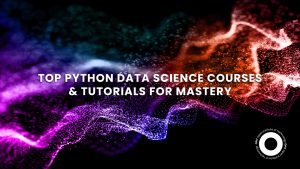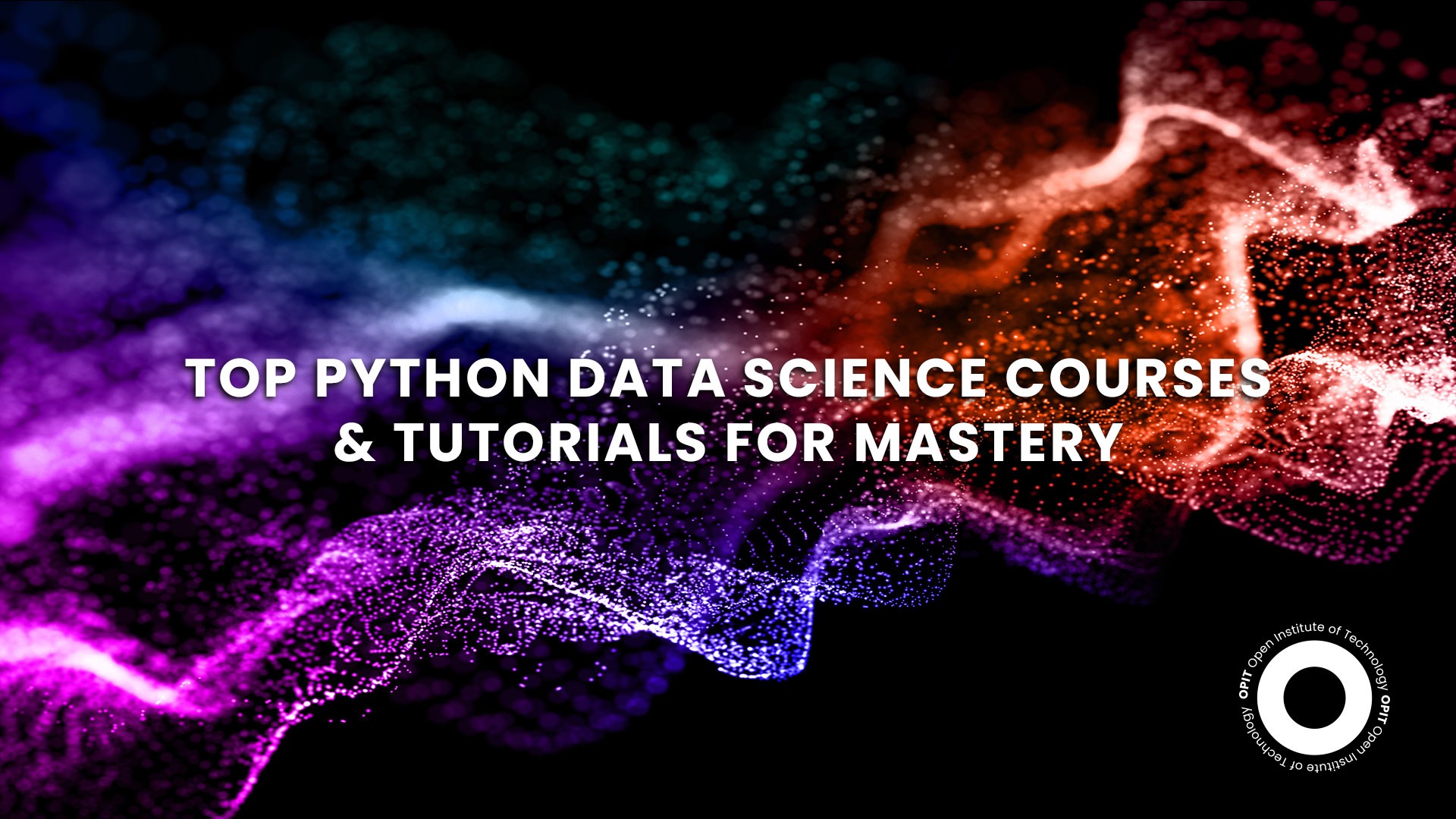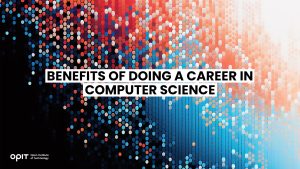

As a well-known programming language, Python dominates the data science field. Its prominence in the industry represents the main reason why so many job offers include Python skills as a hard requirement.
Of course, all of the hype around Python has practical ramifications. This programming language is suitable for people without a programming background. If you have a sufficient grasp of technology, chances are you’ll get how Python works in a few weeks.
Besides being beginner-friendly, Python is practically built for math and statistical analysis. Plus, data visualization becomes nearly effortless when you use specific Python libraries dedicated to the task.
The point is that Python makes numerous data science tasks and operations easier. If you’re interested in data science, learning this versatile programming language will take your professional development to a new level.
Fortunately, you can find plenty of courses teaching everything from the basics to advanced functions in Python. Let’s look at the best Python data science tutorial and course options.
Factors to Consider When Choosing a Python Data Science Course
Before you start a particular course, it would be best to consider the specifics. The criteria that should guide your decision include:
- The content of the course: Some courses will be introductory, while others will offer advanced lessons. You should start with a course that aligns with your proficiency level.
- Instructor’s expertise: Ideally, you’ll want an industry expert to teach you about Python. Experienced lecturers or proven professionals will know all of the ins and outs, and they’ll be able to transfer that knowledge to you.
- Course duration and flexibility: If you’re looking for a course, you don’t want an experience that will last an entire year. On the other hand, you shouldn’t expect too much from an hour-long course. Additionally, the course structure should be flexible enough to allow you to complete it at your own pace.
- Practical projects and applications: Python is a living programming language that sees plenty of use in the real world. On that note, the course you take should offer a hands-on experience and show you how to apply your new knowledge in practice.
- Course reviews and ratings: Although this shouldn’t be your primary clue when making a decision, taking a look at what others say about the course certainly won’t hurt. You’ll want to stay away from courses with mostly negative reviews, especially if the reviewers make unsubstantiated claims.
- Pricing and value: Course pricing may vary from ludicrously expensive to free. While our list doesn’t include any outrageously overpriced courses, you’ll find a quality free one in there. The bottom line here is straightforward: Does the course fit in with your budget and what do you get for the price?
Top Python Data Science Courses and Tutorials
ILX Group – Python E-Learning
This Python data science course deals with the basic functionality of the programming language and teaches you how to apply it in practice. It contains in-depth information about command running, dictionaries, methods, and shell scripting. No final exam is necessary to complete the course.
Key Topics
- The basics of Python programming
- File and data operations
- Logging and test infrastructure
- Conditional statements
- Networking
- Shell scripting
- Django web framework
Instructor’s Background
Information about the instructor for this course isn’t available on ILX Group.
Course Duration and Format
The course is in e-learning format and is delivered entirely online. It will take you about eight hours to complete. Instead of a final exam, you’ll complete the course by submitting the required project that must meet specific set criteria.
Pricing and Enrollment
Enrolling in this course will cost €450 +VAT. You won’t need to fulfill any additional requirements to make a start. Paying the one-time fee will grant you a full year of access to the course resources.
Pros
- Provides a solid foundation for Python programming
- No limitations on enrollment or availability
- Offers practical knowledge and projects
Cons
- E-learning tools used throughout the course aren’t defined
- No information about the instructor or their credentials
Python Institute – Data Analysis Essentials With Python
The Python Institute is a group devoted to Python education. The Data Analysis Essentials with Python is only one of the courses this institution provides. It’s an intermediate-level program focused on data analysis using the tools within the Python programming language.
Key Topics
- Data analysis
- Algorithmic and analytical thinking
- Data visualization
- Statistics
- Data mining and modeling
- Programming
- Data-based decision-making
Instructor’s Background
No instructor information can be found on the Python Institute site regarding this particular course. However, it’s worth mentioning that the institute is run by industry experts with substantial experience in the IT sector. These experts are also responsible for the institute courses.
Course Duration and Format
The Data Analysis Essentials with Python course will last for up to six weeks, provided you devote about eight hours weekly to studying the material. The course is delivered online.
Pricing and Enrollment
One of the greatest advantages of this course is its pricing: Data Analysis Essentials with Python is completely free. However, this course isn’t for beginners. You’ll need previous knowledge of the key concepts in Python programming. The Python Institute recommends completing their beginner courses or coming into this program with some experience.
Pros
- Course designed by industry professionals
- Free for all users
- May serve as a preparatory course for Python Certified Associate in Data Analytics (PCAD) certification
Cons
- No information about the lecturer
- Exact delivery methods aren’t specified
Python-Course – Fundamental Python Course
The Fundamental Python Course is designed as a comprehensive introduction to programming methods in Python. The course will take you through the fundamentals of the programming language and include practical solutions in the Python environment.
Key Topics
- Python introductory lessons
- Script editing and execution
- Working in the Python shell
- Expressions, operators, assignments, and variables
- Dictionaries, stacks, loops, and lists
- Handling files and exceptions
- Conditional statements
- Packages and modules
Instructor’s Background
The instructor for live courses is Bernd Klein. A Python expert with a Saarland University diploma in Computer Science, specializing in computer languages, Klein has taught at the Saarland University, EWH, Koblenz, and the University of Freiburg, where he still holds a teaching position.
Klein is also the founder of the programming language teaching platform, Bodenseo.
Course Duration and Format
The course lasts for five days and includes a live class format. While Klein usually holds classes in person, courses are currently provided online. To participate on this course, you’ll need a network-ready computer with a microphone. No additional software is needed.
Pricing and Enrollment
The on-site variant of the course costs €1,450 per day, while open classes start from €349 daily. There are no other requirements for the course.
Pros
- Taught by an experienced lecturer
- Offers a complete coverage of Python-related subjects
- Advanced optional topics
Cons
- Very pricey compared to the competitors
- Doesn’t provide a certificate
Additional Resources for Mastering Python Data Science
If you want an alternative to an actual Python data science course, you may wish to turn to other resources that will help you master the subject. In particular, these would be books and digital resources like forums, eBooks, podcasts, YouTube channels, websites, and blogs.
For some of the best Python forums and online communities, check out the following:
- Python org forums
- StackOverflow Python forum page
- FreeCodeCamp Python category
Great books on Python include:
- Head-First Python, by Paul Barry
- Think Python, by Allen B. Downey
- Learn Python 3 the Hard Way, by Zed A. Shaw
- Python Crash Course, by Eric Matthes
If printed media isn’t your style, you can find an excellent list of free Python eBooks on Codeburst.io.
On the other hand, you might not want to read too much while learning Python. In that case, you’ll be glad to learn that there are numerous podcasts on the subject that you can tune in to right now:
Unsurprisingly, YouTube also has plenty of Python data science course and tutorial channels. Here are our top picks:
- The New Boston
- Sentdex
- Real Python
- PyCon – This isn’t a particular YouTube channel, but rather a search query. Browse the search results on YouTube, and you’ll find videos for Python-dedicated conferences from around the world.
- Michael Kennedy
Finally, there’s an abundance of blogs and websites dedicated to Python resources and knowledge:
- Python Blogs
- The PyCharm Blog on Jet Brains
- The Invent with Python Blog
- The Python Library Blog
- Finxster
Learn to Program in Python Like a Pro
The internet is full of quality Python data science tutorial and course pages. You can find free and premium resources to hone your skills in the programming language or get familiar with the fundamental concepts.
Whichever resource type you choose, rest assured that learning practical Python skills will be a valuable addition to your resume. After all, data science is a constantly developing field in which expanding your knowledge base and skillset can only be a huge plus. If you’ve found a program you like in this article, don’t hesitate to jump right into it and expand your horizons.
Related posts

Life is unpredictable. While many of us have specific hopes and expectations of how our futures will turn out, things don’t always go as expected. There are many variables and unexpected incidents that can interfere and force you to alter your plans, and this is particularly true when it comes to education.
For instance, you might have had plans to study a specific subject, but had to deviate from those plans due to unforeseen circumstances. Or you may have had to enter the workforce in an occupation different from the one you sought in an effort to earn an income, a move that may not provide you with the time or opportunity to achieve your desired educational aims.
In short, every individual’s career pathway is different, and very few go exactly as we expect from the outset. Fortunately, even if you experience a few false starts or sudden twists in your pathway, there are always options available to help you get back on track.
The Unpredictable Nature of Education
In theory, the educational process seems simple. You select a course of study that interests you from the vast array of subjects and prospective professions, select the appropriate classes, acquire the knowledge and skills you need to succeed, and then embark on your profession.
In reality, however, as many people know from firsthand experience, the road to education is often far from straightforward. Here are just some of the many challenges that can take your educational path in a completely different direction:
- Life’s Curveballs: As touched on in the introduction, life is impossible to predict. Financial hardships, health issues, and family emergencies are just some of the unfortunate occurrences that might derail even the most perfectly planned educational regime.
- Changing Interests: People’s desires and preferences don’t necessarily stay the same throughout their entire lives. As you grow, learn, and have new experiences, your interests may change, and so, too, may your educational objectives.
- Pressure and Burnout: Some academic paths are particularly challenging, demanding intense levels of study and hard work. This can sometimes prove too much to bear, even for the most resilient students.
- Failures and Setbacks: Conventional education largely builds around tests and examinations, requiring students to demonstrate their competencies repeatedly. It’s a system that doesn’t suit everyone, and test failures can lead to setbacks and delays.
- Inequality: People can be born with very different privileges and levels of access to education. Those in certain parts of the world may find it much more challenging to complete their education path for financial, cultural, or even political reasons.
- Late Bloomers: People develop at different paces. Some may struggle educationally early on in their lives, forcing them to make certain concessions or sacrifices related to their studies, only to find their feet later in life once they’ve entered the world of work.
Whether you’re a late bloomer, have had your educational aspirations delayed by personal problems, desire to learn new skills and try something different, or want to begin a fresh chapter in your professional life, the Open Institute of Technology (OPIT) may be able to help.
Introducing OPIT
OPIT is an online teaching platform, making high-level technological educational programs accessible to all, no matter their age or background. Offering education in fields like computer science, artificial intelligence, and digital business, OPIT provides a curated collection of degrees. In addition, they offer classes taught by world-leading tutors imparting the wisdom and skills students need to achieve their goals and become the tech leaders of tomorrow.
Meanwhile, for those who have had somewhat tumultuous or unpredictable educational paths, OPIT offers the perfect course corrector: the OPIT Foundation Year.
The OPIT Foundation Year
OPIT’s Foundation Year is a Pre-Tertiary Certificate in Information Technology, fully aligned with MQF/EQF Level 4 standards and valued at 60 ECTS credits. Lasting just one year, this program essentially serves as a comprehensive yet accessible springboard towards higher-level education, creating a path towards degrees and careers in dynamic, flexible fields, like computer science and digital business.
Like other OPIT programs, the Foundation Year is delivered entirely online via the OPIT Virtual Learning Environment. Combining live lectures, asynchronous content, and interactive assessments, students enjoy diverse and dynamic study experiences, acquiring core skills like academic writing, mathematics, and computer literacy, and building a bedrock of knowledge and confidence before taking their next steps.
Who Is the Foundation Program For?
The Foundation Program is designed to provide a solid base upon which to build the technological education many students need. It’s the perfect choice for those who are eager and ambitious to enter professions in AI, data science, and computing, but don’t feel that they have the necessary core skills and knowledge needed to dive straight into a degree.
Entry requirements are relatively relaxed in order to allow as many students as possible to enjoy the benefits of this program. With that said, applicants should ideally hold an MQF/EQF Level 3 or equivalent qualification, with the intention of pursuing a bachelor’s degree. A minimum of B2 level of English proficiency is also required, as this is the working and studying language of the institution.
What the Foundation Year Provides
Perhaps you’ve recently graduated, are considering a career change, or finally have the opportunity to return to education after initial delays or unexpected disruptions to your original plans. Either way, the Foundation Year can help you enjoy:
- Greater Self-Confidence: Foundation Year graduates gain the fundamental skills they need to enter degree programs with much more self-belief and assuredness.
- Superior Tech Knowledge: Lasting two terms, this course explores mathematics, academic reading and writing, and provides an introduction to computer hardware and software.
- Foundational Mathematics: Mathematics literacy forms a large part of the study focus for the Foundation Year, helping students feel more comfortable with numbers and formulas.
- Flexible Learning: Unlike more rigid, conventional education environments, OPIT gives you the freedom and flexibility to study at a pace that suits you best, all from the comfort of home.
- Global Community: OPIT is an international institution, with staff and students from all around the world eager to share knowledge, exchange ideas, and help one another.
Take Your Next Steps to Success With the OPIT Foundation Year
If you’re curious about a career in technology or have always wanted to work with AI, data, and computers, but struggled to find the time and opportunities you need to acquire relevant skills and knowledge, the Foundation Program was made for people like you.
It’s the ideal entry point into the exciting world of online education, and the perfect first step towards a prestigious degree from an innovative and increasingly successful institution. Download the brochure to learn more about it, or start your online application, today.

Students today have a broader range of fields of study to choose from than ever before, but with the world becoming increasingly technological and computers increasing in influence and importance, pursuing a career in computer science often proves a smart, strategic choice.
There are numerous benefits and career paths associated with studying and working in computer science, and we’ll be listing just a few of them in this guide.
High Average Salaries
With the rising cost of living in many parts of the world, it’s unsurprising that many students are thinking several decades ahead to determine what level of starting salaries they could obtain in different career fields.
Many are also seeking professions that offer the opportunity for growth and the ability to advance up the ranks over time, thus increasing their salary and their quality of life in the process.
If a strong, stable salary with the opportunity for improved income is one of your top career priorities, computer science should be at or near the top of your list of prospective careers.
According to recent data, computer scientists earn an average of over €65,000 per year, with certain jobs, like IT project leader and data scientist, paying ever higher. Starting salaries are strong, too, with graduates earning anywhere from €46,000 to €60,000, depending on their chosen profession and level of qualifications.
There are similarly high average salaries reported around the world in computer science and related fields such as data science and AI/ML engineering. These numbers are projected to increase in the years to come, pointing to computer science as a way for graduates to get off to the best financial start of any career.
Unrivaled Flexibility
A common problem with some subjects and courses is that they only provide graduates with a narrow set of skills and a similarly narrow range of potential professions to which they can apply those skills.
That’s not the case with computer science. Graduates in this field can enjoy instant access to a remarkably diverse array of career opportunities, with even newer opportunities being created all the time as technology evolves and innovations emerge.
A few of the many industries and roles you might choose to enter in the field of computer science include:
- Healthcare: As a software developer, data analyst, or cybersecurity expert
- Finance: As a fintech engineer, blockchain developer, or security analyst
- Media: As a graphics programmer, AI developer, or game developer
- Education: As an analyst, software developer, or machine learning engineer
Guaranteed Opportunities
Some career paths are more limited than others, with relatively low numbers of opportunities, recurring risks of job loss, or difficulty obtaining employment in the first place.
Again, with computer science, this simply isn’t the case. At a time when 75% of companies plan to embrace AI and other technologies by 2027, and businesses of all sizes and industries are now relying on computers more than ever before, computer science graduates can enjoy almost unbeatable job security.
Opportunities will continue to grow for people with good computing knowledge, whether that be in the obvious fields like software and web development, engineering, and AI development, or more niche sectors.
With so many options, you’re effectively guaranteed a long, rewarding career if you put in the necessary time and effort needed to establish a strong foundation of computing skills.
Rapidly Expanding and Evolving Industries
It’s no secret that the world of technology is a dynamic and fast-moving one. In the past 20 years alone, we’ve seen the proliferation of the internet, the rapid advancement of smartphones and wearable devices, the emergence of AI, and so much more.
In the years ahead, engineers and developers will continue to explore the boundaries of modern technology’s powers and potential, driving new innovations and improvements and opening more exciting job opportunities for those already established and experienced in this field.
Getting into computer science now could therefore provide a solid foundation for a career filled with excitement as you uncover and explore new ways of working with computers in fields as diverse as healthcare, finance, education, entertainment, manufacturing, logistics, and beyond.
Start Your Computer Science Career at OPIT
We’ve discussed some of the many benefits associated with careers in computer science, from the high starting salaries to the rapidly growing array of job options available to graduates. By now, you may be eager to follow this particular career path and take advantage of the wealth of opportunities.
If you’re wondering how to start, the Open Institute of Technology (OPIT) may hold the answers you need. As an exclusively online learning platform, specializing in computer science and digital business, and staffed by some of the world’s leading tech experts, OPIT is producing the tech leaders of tomorrow.
Some of the many advantages of learning with OPIT include:
- Accessible and flexible online education that matches your learning style and schedule
- Heavy focus on real-world applications of the skills you acquire
- An international community of like-minded students from around the globe
- A top team of tutors and lecturers from varying fields and industries
- Progressive assessment of skills and understanding – not constant exams
OPIT offers a small, curated selection of courses for those seeking to gain the technological skills and knowledge to succeed in their chosen areas of expertise. That includes a BSc (Hons) in Computer Science – a six-term program, worth 180 ECTS credits.
Numerous IT industry leaders and experts helped develop this fully accredited undergraduate degree, which is online and accessible to all. Like other OPIT courses, it offers a flexible learning program, with progressive assessments, fast-track options, and the opportunity to be part of a growing community of learners and tutors.
If the benefits of doing a career in computer science interest you, download the OPIT BSc in Computer Science brochure or fill out an online application today and take your first step toward a rewarding and fulfilling profession.
Have questions?
Visit our FAQ page or get in touch with us!
Write us at +39 335 576 0263
Get in touch at hello@opit.com
Talk to one of our Study Advisors
We are international
We can speak in:


